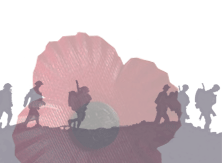John Skinner VC
Their names will be remembered for evermoreThe description of a daredevil soldier emerging from a fortified post, a machine gun under each arm and with 37 prisoners trooping behind him, almost makes John Skinner sound like a comic super-hero. He was already wounded in the head when he gathered six men and dashed for the "block houses", emerging soon after with his haul. He then stormed two remaining forts, increasing the prisoner count to 60. Newspaper articles, written by a soldier-journalist for the War Office, may have made Skinner look like he took on the German army single-handed, but they were not far off the mark in recording the cockiness that made him the soldier he was. Reckless but Talented Soldier Skinner had lied about his aged to enter the King's Own Scottish Borderers at 16, and by the outbreak of war had seen 14 years' service, including in the Boer War in South Africa, followed by India and the Middle East. A colourful personality and with a tendency to be reckless, the wounds he suffered were as frequent as his demotions for ignoring regulations or drinking. However, his army records praise him as a very intelligent and hard-working infantryman, and by August 1914, he was with the 2nd Battalion in France, promoted to acting sergeant. Within two months he had been awarded the Distinguished Conduct Medal for scouting a wood after heavy enemy engagement. Over the next three years Skinner began appearing in newspapers for the number of times he was sent to hospital only to return to service, and reputedly competed with his friend to see who could acquire the most official "wound stripes". Action at Mons, Bethune and Ypres as well as the disastrous Gallipoli campaign all left with him with shrapnel or gunshot wounds to his foot, torso, head and shoulder. His daring willingness to be at the front of the action secured three mentions in dispatches. No doubt it was this insatiable bravado that was behind his actions on 16 August, 1917, in another famous battle, Passchendaele. Skinner had been promoted to acting company sergeant major at Wijdendrift in Belgium. The German lines had been fortified with concrete block houses, machine gun posts which were holding up the regiment's advance. Sixty Prisoners Captured Soldier-journalist Lieutenant James Price Lloyd was writing press releases for the War Office to boost morale, and recounted that: "In spite of the fact that Skinner had been wounded in the head, he hastily collected six men and dashed towards the block houses. The first he captured single-handed. He reappeared laboriously carrying two machine guns, one under each arm, and followed by the whole garrison as prisoners." He led his men against the other two block houses, capturing 23 more prisoners, three more guns and two trench mortars. Another sergeant also gained the VC for the raid. During an investiture at Buckingham Palace on 26 September, 1917, Skinner received his VC wearing seven wound stripes - badges on a soldier's sleeve denoting his injuries. He was also presented to Glasgow City Council and visited his old schools, including Allan Glen Boys' School. He got married, and later that month was promoted to warrant officer, and awarded the French Croix de Guerre for the actions that gained him the VC. Six VCs Honour Comrade He was later posted to Edinburgh, but decided to ignore his orders and return to his unit in Belgium. There, on 17 March, 1918, his luck finally ran out when he was shot and killed as he tried to rescue a wounded man. At his funeral in Vlamertinghe, Belgium, his coffin was carried by six other VCs, including a general and a private standing shoulder to shoulder. It was thought to be the only time six VCs had acted as pall bearers. Skinner, who was born in Maryhill, was the third son of a tailor. His elder brother had been apprenticed to his father at their upmarket gents' outfitters in Royal Exchange Square. The army offered a more exciting career, and Skinner didn't shrink from it. John Skinner's citation in The London Gazette View original referenced text here: |
Images:
|

















